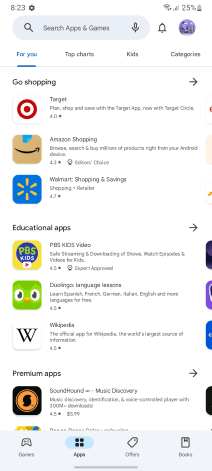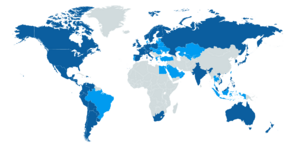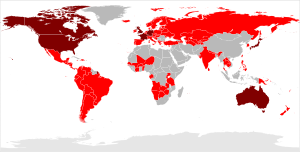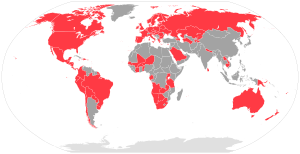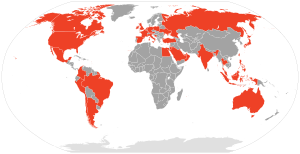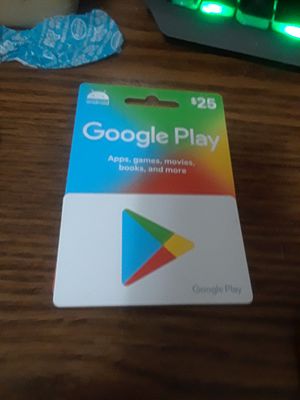Google Play facts for kids
| Developer(s) | |
|---|---|
| Initial release | October 22, 2008 (as Android Market) March 6, 2012 (as Google Play) |
| Platform | Android, Android TV, Wear OS, ChromeOS, Web |
| Type | Digital distribution, App store, Mobile game store, Video on demand, Ebook store
Online music store (closed in December 2020) |
Google Play, also known as the Google Play Store, is a special online shop run by Google. It's the official place to find and download apps for devices that use the Android operating system, like your phone or tablet. You can also use it on ChromeOS devices. Google Play isn't just for apps; it also offers games, movies, TV shows, and books. If you buy something on Google Play, you can usually access it from a web browser or through apps on Android and iOS devices.
You can get apps from Google Play for free or buy them. You can download them right to your Android device using the Google Play Store app, or send them to your device from the Google Play website. Some apps use special features of your device, like a motion sensor for games or a front-facing camera for video calls. In 2016, people downloaded over 82 billion apps from Google Play. In 2017, there were over 3.5 million apps available. While Google has removed some apps for safety, there are still over 3 million apps today. Google Play has sometimes had issues with harmful apps, but Google works to keep the store safe.
Google Play started on March 6, 2012. Before that, it was known as the Android Market. Google brought together Android Market, Google Music, Google Movies, and the Google eBookstore under one name: Google Play. This changed how Google offered digital content. Over time, Google has moved some of these services to other brands. For example, Play Music became YouTube Music and Play Movies & TV became Google TV.
Contents
What You Can Find on Google Play
Android Apps
By 2017, Google Play had more than 3.5 million Android apps. After Google removed some apps, the number is now back to over 3 million. Developers from more than 150 places can share their apps on Google Play. Developers get 85% of the app's price, and Google uses the other 15% for distribution and fees. Developers can also offer sales on their apps. Google Play lets developers release early versions of apps for testing, called alpha or beta tests. You can even pre-order some apps, movies, music, books, and games to get them as soon as they are ready. Some phone companies let you pay for Google Play purchases through your monthly phone bill instead of a credit card. If you buy something and change your mind, you can ask for a refund within 48 hours.
Games
In 2013, Google launched Google Play Games. This is an online gaming service for Android devices. It lets you play games with other people in real-time. It also saves your game progress in the cloud, so you don't lose it. You can see leaderboards to compare your scores with friends and earn achievements. A special app for Google Play Games was released in July 2013.
Books
Google Play Books is a service where you can buy and read ebooks. Google Play offers over five million ebooks to buy. You can also upload up to 1,000 of your own ebooks in PDF or EPUB formats. As of 2017, Google Play Books was available in 75 countries around the world.
Movies and TV Shows
Google Play Movies & TV used to be a service where you could buy or rent movies and TV shows. As of 2017, movies were available in over 110 countries. However, TV shows were only available in a few countries like Australia, Canada, France, Germany, Japan, the United States, and the United Kingdom. In October 2020, Google Play Movies & TV was renamed Google TV. Google also announced that by May 2022, movies and TV shows would be fully moved from the Google Play Store to the Google TV app.
Play Pass
On September 23, 2019, Google started a new service called Google Play Pass in the US. It's a subscription service for games and apps. If you subscribe, you can use these games and apps without seeing ads or having to make extra purchases inside the app. Developers are invited to join this program and can add their existing apps to it.
Device Updates
Google introduced something called Project Mainline in Android 10. This allows important parts of the Android operating system to be updated through the Google Play Store. This means your device can get important updates without needing a full system update. For example, security features and privacy settings can be updated this way. In 2019, Qualcomm announced that some of their Snapdragon chips would also support updating graphics drivers through the Google Play Store.
Teacher Approved Apps
In 2020, Google added a new section to the Google Play Store just for kids, called 'Teacher Approved'. Apps in this section meet higher standards and are approved for learning and educational purposes. This helps parents and kids find safe and useful apps.
How Google Play Started
Google Play came from three different products that Google had before. These were Android Market, Google Music, and the Google eBookstore.
The Android Market was first announced by Google in August 2008 and became available to users in October. In December 2010, Google added ways to filter content and increased the maximum size for apps. The Google eBookstore launched in December 2010 with three million ebooks, making it the largest collection of ebooks at the time. In November 2011, Google announced Google Music, which let people buy music. In March 2012, Google made it possible for apps to be much larger by allowing developers to add extra files. Also in March 2012, the Android Market changed its name to Google Play.
The Google Play Store, with all its Android apps, also became available on ChromeOS devices in September 2016. In May 2021, Google Play announced that it would add a new section with privacy information for all apps. This section will show users what kind of information each app collects and how it's used.
Music
Google Play Music was a service for streaming music and podcasts. It also let users store up to 50,000 of their own songs in the cloud for free. It had over 40 million songs. As of 2017, Google Play Music was available in 64 countries. In 2018, Google announced that Play Music would be shut down by 2020. Users were encouraged to move their music to YouTube Music. Google Play Music officially closed in December 2020.
News and Magazines
Google Play Newsstand was a service that brought together news and digital magazines. You could subscribe to magazines and news feeds. Google launched Newsstand in November 2013, combining features from Google Play Magazines and Google Currents. As of 2017, the basic Newsstand service was available worldwide. Paid content was available in over 35 countries. In May 2018, the mobile app merged with Google News & Weather to become Google News. The Newsstand section on the Google Play website was removed in November 2018.
Devices
Until March 2015, Google Play had a "Devices" section where you could buy Google devices like Google Nexus phones, Chromebooks, and Chromecasts. On March 11, 2015, Google launched a separate online store called the Google Store for all its hardware products.
How Google Play Looks and Works
You can search for content by name or by keywords that developers provide. When you search for apps, you can use filters to find exactly what you're looking for. Google Play Store also has lists of popular apps, like "Top Free" (most popular free apps) and "Top Paid" (most popular paid apps). There are also lists like "Editors' Choice," which features apps chosen by the Google Play team as the best. In March 2017, Google added a "Free App of the Week" section, offering a paid app for free.
Google Play shows how popular an app is by displaying how many times it has been downloaded. This is shown with a color-coded badge. For example, a green badge means 100,000 or 500,000 downloads, and a red/orange badge means 1 million, 5 million, 10 million, or even 1 billion downloads!
Users can write reviews and give ratings for apps and other content on Google Play. These reviews are public. App developers can also reply to these reviews.
Design Changes
Google has updated the look of Google Play many times. In February 2011, Google launched a website version of the Android Market, so you could access it from a computer. Apps bought on the website would download to your Android device remotely. In July 2014, the Google Play Store app on Android got new sections for Books and Movies. It also showed more details about apps, like their size and content rating. A few days later, it was updated to match Google's new Material Design style. In April 2016, Google changed the icons for all its Play apps to have a similar, consistent look. In July 2022, Google announced a new logo for the Google Play Store that has colors similar to other Google services.
Google Play Instant Apps
Launched in 2017, Google Play Instant lets you use an app or game without installing it first. This is great for trying out games or apps quickly!
How Apps Make Money
Google allows developers to make money from their apps in different ways. This includes selling apps, offering in-app purchases, subscriptions, and showing ads. Google requires developers to use Google Play's payment system for paid apps and most in-app purchases. This helps make sure everything is fair for users. Support for paid apps started in February 2009 in the US and UK, and then expanded to more countries. In-app purchases were introduced in March 2011. Since September 2014, all developers on Google Play must show a physical address on their app's page.
In February 2017, Google allowed developers to set sales for their apps, showing the original price crossed out. Google also changed how it promotes games, focusing more on how much users enjoy them, not just how many times they are downloaded.
Payment Methods
Google lets users buy content using credit or debit cards, carrier billing (paying through your phone bill), gift cards, or PayPal. Carrier billing started in May 2012, and PayPal support was added in May 2014.
Gift Cards
Google Play gift cards became official in August 2012. These cards let you add money to your Google Play account to buy apps, games, movies, and more. As of April 2023, Google Play gift cards are available in many countries around the world.
Subscriptions
Google introduced in-app subscriptions in May 2012. In June 2016, Google changed how it splits revenue from subscriptions. Developers now receive 85% of the money, and Google takes 15%. This was a change from the previous 70/30 split. As of January 1, 2018, the fee for subscriptions drops to 15% after a user has subscribed for 12 paid months.
Google Play Store on Android Devices
| Developer(s) | |
|---|---|
| Initial release | October 22, 2008 |
| Operating system | Android |
| Type | Digital distribution, App store |
The Google Play Store app is usually already on Android-certified devices. It gives you access to all the content on Google Play, like apps, books, and movies. In China, devices don't come with the Google Play Store, so manufacturers offer their own app stores.
The Google Play Store only shows you apps that work with your specific device. Developers can make apps for devices with certain features, like a compass or a specific Android version. Phone companies can also prevent certain apps from being installed on their users' devices.
You don't have to get Android apps from the Google Play Store. You can download them from a developer's website or other app stores. Android apps are stored as APK files, which are like `.exe` files on Windows computers. On Android devices, there's a setting called "Unknown sources" that lets you install APKs from places other than the Google Play Store. Some apps can also be installed on an external storage card.
App History
The Google Play Store app keeps a list of all the apps you've installed. You can remove apps from this list, and these changes will also show up on the Google Play website.
Compatibility
Google shares the code for Android through the "Android Open Source Project." This lets people create their own versions of Android. However, not all these versions work with apps made for Google's official Android. The "Android Compatibility Program" makes sure that devices can run apps made by developers. Only Android devices that follow Google's compatibility rules can install and use the Google Play Store app.
Since August 2019, all new and updated Google Play apps must work with 64-bit devices. Since August 2021, Google Play will not send apps that only work with 32-bit devices to phones that can use 64-bit apps.
Google Play Services
In 2012, Google started to separate parts of its Android operating system. This meant that important parts, like core apps, could be updated through the Google Play Store without needing a full operating system update. One of these parts is Google Play Services. This is a special system that helps Google services work on Android devices. It's automatically installed on most Android devices. This change allows Google to add new features and update apps without needing to update the entire operating system.
App Growth Over Time
| Year | Month | Apps Available | Downloads to Date |
|---|---|---|---|
| 2009 | March | 2,300 | |
| December | 16,000 | ||
| 2010 | March | 30,000 | |
| April | 38,000 | ||
| July | 70,000 | ||
| September | 80,000 | ||
| October | 100,000 | ||
| 2011 | April | 3 billion | |
| May | 200,000 | 4.5 billion | |
| July | 250,000 | 6 billion | |
| October | 500,000 | ||
| December | 10 billion | ||
| 2012 | April | 15 billion | |
| June | 600,000 | 20 billion | |
| September | 675,000 | 25 billion | |
| October | 700,000 | ||
| 2013 | May | 48 billion | |
| July | 1 million | 50 billion | |
| 2016 | 82 billion | ||
| 2017 | February | 2.7 million |
Google Play Awards
In April 2016, Google started the Google Play Awards. These awards celebrate great app developers and highlight some of the best apps and games. There are five nominees in ten different categories. The apps are chosen by experts on the Google Play team based on how good and new they are. The winners are announced in May.
Google has also released yearly lists of what it considers the "best" apps on Google Play. On March 6, 2017, five years after Google Play launched, Google released lists of the best-selling apps, games, movies, music, and books from the past five years. In June 2017, Google introduced "Android Excellence," a new program to highlight apps that Google Play editors think are of the highest quality. In 2020, Disney+ was named the top app of the year for US users, and SpongeBob: Krusty Cook-Off won in the gaming category.
App Approval and Safety
Google has rules about what kinds of apps can be published on Google Play. They don't allow apps that promote child harm, violence, bullying, hate speech, gambling, or illegal activities. They also require special care for apps where users can create their own content.
In March 2015, Google started using both computer tools and human reviewers to check apps for harmful software (like viruses) and to make sure they follow the rules before they are published. At the same time, they started a new age-based rating system for apps and games.
In October 2016, Google announced a new system to find and filter out apps that try to cheat the system. This includes apps that try to get more downloads or fake reviews unfairly. In April 2019, Google made changes to how apps are reviewed. New developers might have their app submissions reviewed for several days to ensure they are safe and follow the rules.
App Bans
Sometimes, mobile carriers (phone companies) can block users from installing certain apps. For example, in March 2009, some apps that allowed "tethering" (sharing your phone's internet connection) were removed from the store because they went against T-Mobile's rules. Google later fixed this so only T-Mobile users were affected.
In April 2011, Google removed the Grooveshark app because it violated policies, possibly related to copyright. In March 2013, Google started removing apps that block ads because they interfered with servers and services. Apps that use too much power without a good reason are also banned. In July 2018, Google banned more types of apps, including those that mine cryptocurrency on your device, sell weapons, or are just used to show ads.
In 2022, some Iranian apps were removed because they were found to be harmful software.
App Security
In February 2012, Google launched an automatic system called Google Bouncer to scan new and existing apps for harmful software like spyware or trojan horses. In 2017, Bouncer and other safety features were combined under the name Google Play Protect. This system regularly scans apps for threats.
Android apps can ask for certain permissions on your device, like access to your camera, contacts, location, or microphone. In July 2017, Google started a new security effort called "peer grouping." This groups apps that do similar things, like calculator apps. If one app asks for more permissions than others in its group, Google's systems will flag it for a closer look by security experts.
Security Issues
In March 2011, a harmful program called DroidDream was found in some free apps on the Android Market. This program could steal information like your phone's unique ID. Google removed the apps quickly, but they had already been downloaded many times. Google then added a "remote kill" feature to remove harmful apps from users' devices.
In 2012, a security company showed that they could upload an app that would get past Google's Bouncer system. This app could steal contacts and messages. It stayed on Google Play for over two weeks without being detected. This showed that Google needed to do more manual testing of apps.
A study in 2014 found that harmful apps on Google Play increased a lot between 2011 and 2013. In October 2016, a hacker found serious problems with how some privacy apps stored passwords. In April 2017, a harmful program called "FalseGuide" was found hidden in about 40 game guide apps. This program could show pop-up ads and launch attacks. Google removed these apps, but about two million users had already downloaded them.
In June 2017, researchers found 47 apps that showed annoying ads even after the app was closed. In August 2017, 500 apps were removed because they contained harmful advertising software. In all of 2017, over 700,000 apps were banned from Google Play, which was a big increase from 2016.
In March 2020, harmful programs called Tekya and Android.Circle.1 were found in many apps. These programs could trick users into clicking on ads or steal their information. In July 2021, apps that stole Facebook logins were found. In September 2021, a harmful program called GriftHorse infected over 10 million Android devices by signing them up for paid services without their knowledge. In November 2021, researchers found more harmful apps that pretended to be normal apps but then secretly installed banking viruses. Google works to remove these apps once they are found.
Patent Issues
Some app developers on Google Play have been sued by "patent trolls." These are people who own very general patents and use them to target small developers. If a developer tries to fight the lawsuit, the patent troll might change their claim to accuse the developer of violating a different part of the patent. This can be very expensive for developers, so some choose to settle. This situation has led to discussions about whether developers might stop making apps because they are afraid of patent problems.
Images for kids
See also
 In Spanish: Google Play para niños
In Spanish: Google Play para niños


